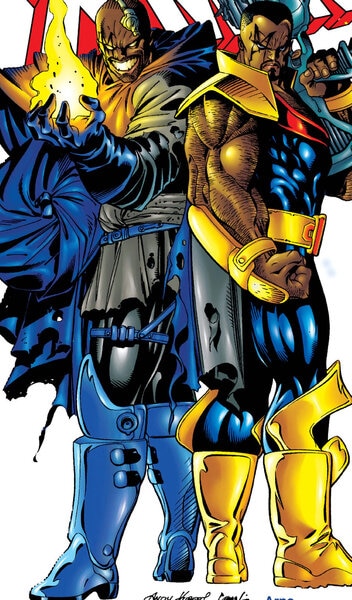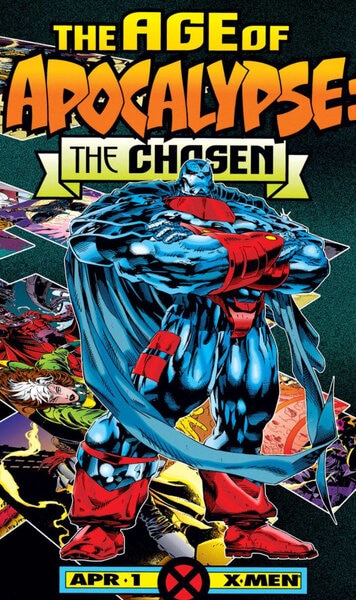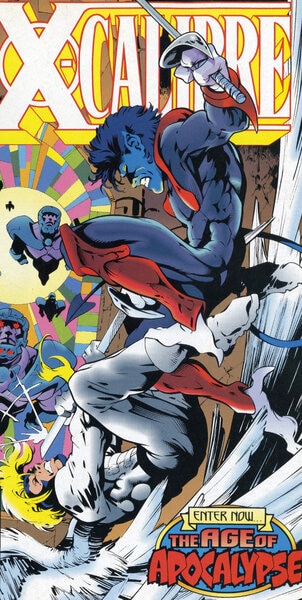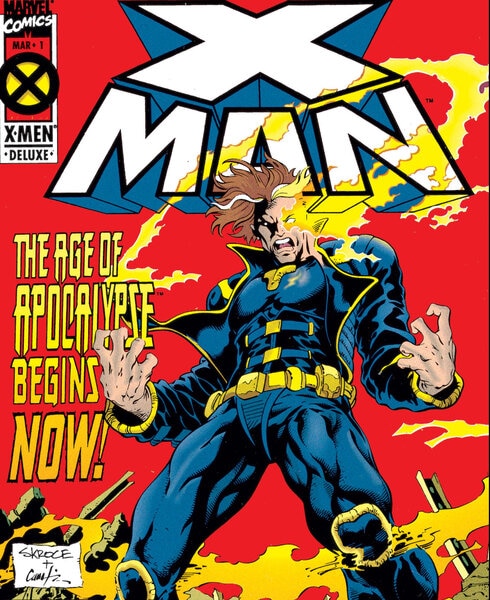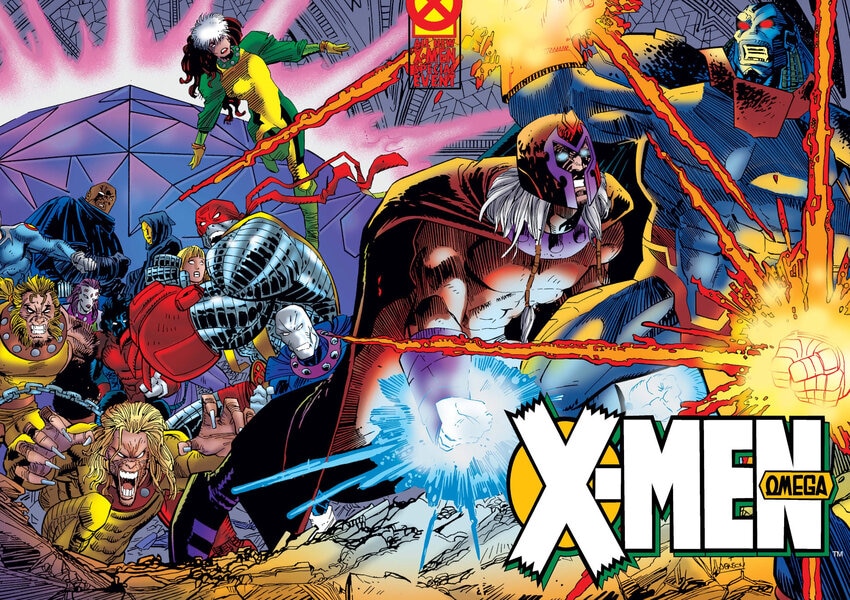Create a free profile to get unlimited access to exclusive videos, sweepstakes, and more!
One for the Ages: An oral history of Age of Apocalypse, the X-Men’s massive crossover, 25 years later
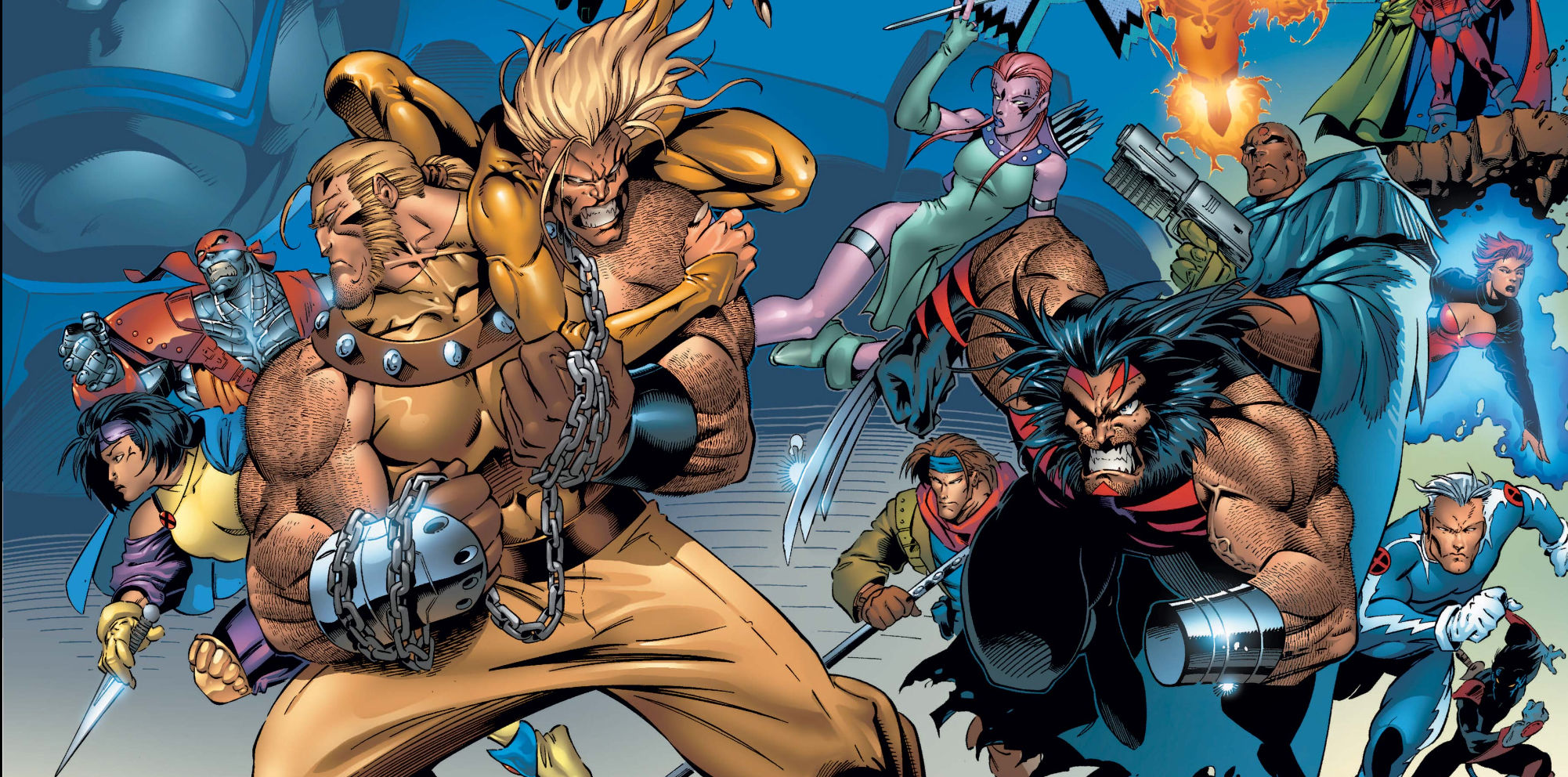
The year is 1994, and it would not be underselling anything to say it's a high point in a soaring era for Marvel's merry band of mutants. The X-Men are still riding the wave of the record-setting sales on 1991's X-Men #1 by industry superstars Jim Lee and Chris Claremont, and at this point there are no fewer than seven monthly titles and a quarterly book devoted to new stories in the X-Universe.
It's the sort of franchise success of which publisher dreams are made, so it's more than a little bit baffling when Marvel reveals its plans to cancel all of its monthly X-titles and replace them with a game-changing storyline, known as the Age of Apocalypse. It's a fitting name, given the shock so many X-fans are feeling in the wake of the big announcement.
But as we know now, it all worked out, to say the least. The story, stretched over the course of a four-month event, tracked how the removal of Professor Xavier would lead to a dark dystopia ruled by the X-Villain Apocalypse. Grim stuff, but a stroke of brilliance in hindsight. Not that it was any one person's grand idea — at Marvel, it takes a team to make something this big happen.
To look back on the event 25 years later, SYFY WIRE spoke with many of the contributors who worked on the story, which still stands as one of the most logistically challenging and enduring X-Men sagas of all time.
At the time, what was known as the X-office over at Marvel's New York publishing headquarters was no stranger to expansive crossovers within the X-Men Universe of titles. Dark Phoenix, Days of Futures Past, The Brood Saga, The Mutant Massacre, Inferno, Fatal Attraction — all game-changing events in X-history. Yet this would top them all.
Ben Raab (Assistant Editor, Age of Apocalypse): We did have a brain trust. Bob Harras, Scott Lobdell, and Fabian Nicieza were sort of the core minds behind this. Bob being the group editor at the time, I think this was before he was officially editor-in-chief for all of Marvel.
Fabian Nicieza (Writer): The entire project, I believe, started with editor Bob Harras showering. It was at some point within that lathering cycle that he came up with a question.
Scott Lobdell (Writer): I remember I was in New York. It was raining. I passed a pay phone and figured I'd check my messages. There was a message from Bob, who was like, "What if Jubilee went to the X-mansion and everybody there claimed they were X-Men, but she didn't know any of them?" So I called back and said, "That would be awesome, but what if they really were the X-Men? What if she was wrong? And she was actually in a world where suddenly everything she knew about the X-Men was wrong."
Nicieza: He presented it to Scott first, since they were more simpatico with that kind of story development together. The two of them talked out the possibilities, then pitched it to me.
Lobdell: Bob and I eventually got together in person. We started talking about "How can we create a world where the X-Men aren't really the X-Men?" Eventually, we decided that the only thing that would really change the team is if Professor X had died. So we're like, "Can we go back in time and kill Professor X?"
Nicieza: I loved the idea, and we knew it would become even bigger than our usual publishing budget-expected crossovers.
Lobdell: Originally it was just going to be in Uncanny X-Men, like the original Days of Futures Past story. The more we talked about it, we said, "If we did kill Professor X, it would change virtually everything there is to change about the X-Men. Is this too crazy for our crossover?"
Raab: Bob was a big Star Trek fan. I think the Next Generation episode "Yesterday's Enterprise" had a huge impact on the conception of this story. That idea of Tasha Yar getting a second chance. This other new reality is created, and it inspired what we wanted to do with AoA.
Lobdell: Bob and I realized that it was going to be a Legion (the son of Professor Xavier) who would kill the professor, primarily because of his ability to move back through time. Well, why would Legion want to kill the Professor? That didn't make sense to me. It was Mark Waid, I believe, who at that point had been moving his way over into the X office, who suggested, "What if he wasn't trying to kill his father, but actually wanted to kill Magneto but the Professor got in the way?"
The time-travel element would take us back to a point in Magneto and Xavier's early life where they weren't just allies, but friends as well.
Lobdell: There were other details that needed to be ironed out. Jubilee wouldn't work as that character who would remember the world as it was, so we went with Bishop (who was trapped in the past with a team of X-Men who had traveled back to stop Legion. Their failure to stop Legion resulted in Bishop being alone and stuck in the new timeline). He had come back from an alternate future into our time, so he would be the one most likely to realize that something was completely wrong about this new world. Yet to everyone around him he would come across like a war veteran suffering from PTSD.
Nicieza: I wasn't very involved at all with the early stages, to tell you the truth. That was the point where I was writing six monthly titles and had a full-time editorial job, so I wasn't in a position to grind that out. I had navigated a lot of heavy lifting on the Avengers' Operation Galactic Storm and Nomad's Dead Man's Hand crossovers, was working on the New Warriors/X-Force crossover, I didn't have the bandwidth to worry too much about another X-crossover.
Lobdell: I was in Bob's office and I remember this really clearly. I often get in trouble for saying what I think are patently ridiculous things that ultimately get me in trouble because people don't realize that what I'm saying is clearly the most ridiculous thing I can think of at the time. But in this case, Bob was on the phone and he goes, "I don't know. Oh, that's an interesting question" — [then] puts his hand over the receiver [and asks]: "The guys in marketing are wondering how they're going to market this as a series." And I go, "Tell them we're canceling everything! We're canceling all the X-books and we're starting over with new number ones." And he goes, "Okay!" He takes his hand off the receiver and repeats what I said. He hangs up and is like, "Yeah, they said they love it! They're all excited."
And so it went. Marvel proceeded to rebrand its eight monthly titles (Uncanny X-Men became Astonishing, Wolverine became Weapon X, Cable became X-Man, etc.). Although to the world at large, pre-internet, and with no indication that this was only a four-month event, this looked like the end of the X-line entirely. Fans were not thrilled.
Raab: When the books were canceled, fans were freaking out. This was when people would call up the Marvel offices and ream us out. I'll never forget I was on the phone with this one fan who was like so pissed and I said, "Look, just wait and see, give it a shot." And after the books finally came out, the guy called me back and was like, "Yeah, you're right!"
Lobdell: There's also a conversation that we had about Generation X, which had just started and it would have been only up to Issue 5 going into Age of Apocalypse. We realized that if we don't do anything with Generation X, just ignore AoA and kept it going, then we run the risk of saying, this book isn't an important part of the X-Universe.
Nicieza: The line-ups were pretty much handed to all of us. These are the altered books and the characters in them. I honestly don't remember jockeying for characters or anything like that. Although I loved the idea of AoA, my enthusiasm level for the X-books at that point was in serious decline, so I decided to just go along for the ride.
Raab: At the initial lunch where we had almost everyone who would be working on this in, we tried to hash out the main questions. So what are the different books going to look like? What's Uncanny X-Men going to look like when it morphs into Astonishing X-Men? What's adjectiveless X-Men [going to] be when it becomes Amazing X-Men? How does Wolverine become Weapon X? etc.
Lobdell: At a point in the lunch, we sat around and we started asking if you could start things from soup to nuts — who would get what character, what character is going to which book?
Raab: The creative rosters were kind of decided upon early. Like Scott would write Astonishing and Fabian doing Amazing, etc. But there was leeway within the context of the larger story to tell whatever version of the story they wanted to tell. X-Men: Alpha and X-Men: Omega were going to bookend [the] entire crossover, but each story could sort of be its own journey for those individual characters in those individual groupings along the way.
Lobdell: You know in those days, you would read a crossover and have to read all 23 parts of it to makes sense. I was adamant and Bob was supportive of saying, "Let's not do it that way. These characters need to be here by the end of your fourth issue to lead into X-Men: Omega. How you get them there is completely in your hands." It took people a bit from our fellow creators to roll with it. At first they were like, "Well, you're just leaving us out here." And I go, "We could tell you where to go, but I think we're giving you the freedom. Go have fun with it."
Nicieza: I'm sure that's what Bob said in theory, but it wasn't remotely that in practical application. Because Scott and Bob had no real idea exactly how this story was going to end, many of the titles had to do a tremendous amount of juggling on the fly to patch in new ideas or fixes, all for the sake of establishing an ending we didn't have yet.
Lobdell: I have gotten better over the years as far as plotting out a story six months ahead. But back then I used to infuriate Fabian. Fabian usually has like 25 issues planned for whatever book he's working on. I was like if someone said to me, "Hey, that's a great cliffhanger," I would be like, "Yeah, I can't wait to figure out what happens next." Rational being, if I could surprise myself, I could surprise the reader. For me, if you planned too far ahead it would be like chewing your food twice.
Raab: Also Howard Mackie eventually got involved, as he and Bob were very good friends.
Mackie, a seven-year Marvel editorial veteran who had left his staff position to write full-time, was at the time enjoying a great deal of success penning many Marvel titles, chief among them the ultra-successful relaunch of the Ghost Rider franchise.
Howard Mackie (Writer, Ghost Rider and X-Men Chronicles): I was up at the Marvel offices, as I often was back then. I wound up coming in the day the sales figures for Ghost Rider, Wolverine, and Punisher: Hearts of Darkness came out. While I don't remember the numbers, I know they were very good. I went into the bullpen and all the way on the other side was my buddy Bob Harras, who yells across the room, "Howard, walk with me!" He said, "Have you ever wanted to do anything for the X-office?" I said, "Not really!" But that conversation became a Gambit mini-series. And suddenly I was in the X-Universe.
Logistically, it was going to be no small feat wrangling eight different creative teams to come up with new stories to fly under the AoA banner.
Mackie: So Bob, for whatever reason, pulled me into one of the X-Men summits he was holding, which he did periodically for writers and artists. He said, "Well, why don't you come?" To which I said, "Bob, I don't actually work in editorial anymore." To which Bob says, "Yeah. But you're good at this stuff. So why don't you just come in?"
This was as Scott was starting to become more of a force in the X-office, but Chris Claremont was still there. I ended up trying to act as a bridge between them. It's at this meeting where they started to lay down the concepts for AoA. I thought it was intriguing. I ended up doing a lot of stuff that other people at that meeting either were uncomfortable doing or couldn't do. I was a cat wrangler at that point. I was brought in to try to make nice between some opposing forces that existed in the room at the time. I had a reputation of being a nice guy, and as someone who knew how to get people to work well with each other. Keep in mind, I had no writing assignment for the project at this point, and I was a full-time writer with books completely unrelated to this. But editorially, I was brought in strictly because of my ability to do that.
Raab: Another question was: What new characters are going to be introduced?
Lobdell: We sat around and we started talking if you could start things from soup to nuts who would get what characters and what character go in what books. If you remember Fabian, whore that he was, and I say that with nothing but affection, he was like, "I want Magneto, and Storm, Quicksilver, and Wolverine and Gambit." He was clearly front-loading his book with the popular characters at the time. And I countered with "I want Changeling, you know, the guy Professor X switched places with? But what if in here, he calls himself Morph like the character from the TV show, and he looks like a number two pencil eraser until he picks a shape?" I went on to ask for Sunfire, with his skin burned off, and Sabertooth with Wildchild on a chain. All the while Joe Madureira, God bless him, is sitting across from me like, "What are you doing?"
Raab: Joe would turn in designs for characters like Sunfire or Blink. We would see these redesigns and think, "These are amazing!"
Ken Lashley (Artist, Excalibur/X-Calibre): I think I had done only a handful of issues, and I think I started in issue number 70. I had done maybe single digits in issues to that point. I remember back in those days, anything under 100,000 copies was cancellations. [Note: compared to today, when 100,00 copies represents a Top 10 selling book.] I think X-Calibre at the time was in the 90s, like 95,000. So they hired me, this kid from Canada, and the book sort of took a positive jump. It was my first job in the business, and a year in I'm doing AoA. So looking back, I was very fortunate to be on a book that size, not realizing what I was getting myself into.
Tony Daniel (X-Force/Gambit and the Externals): I was with Marvel for about two years where I worked on X-Force. I remember thinking it was a radical move but one that could be fun as hell to work on. I remember thinking that this was a huge event. I was happy I was a part of it.
Steve Skorce (Artist, X-Man): Jeph Loeb and I were paired off by editorial. They'd tasked all the X-writers with reimagining their respective books' characters in a world where Professor X never lived to create the X-Men, a dystopia where humanity was being systematically expunged, and there were very few safe places for them left in the world. Jeph imagined a version of Cable that stripped away all of his tropes; he became a boy without a past searching for purpose instead of a middle-aged man with a mission, and whose power was unfettered by the techno organic virus. Instead, he was threatened by his own destructive potential and the manipulation of secret enemies and Apocalypse himself. I was on cloud nine, I thought it was the coolest thing I'd ever heard and was feeling so lucky to be working on it.
Lashley: Again, I'd only been in the business for like five minutes. So character-design-wise, I think Joe Madureira did the Nightcrawler redesign. I did the Juggernaut and some other characters that were in my book.
Daniel: I redesigned all of the characters that were in Gambit & the X-ternals. It was fun putting my own spin on my favorite characters. I remember how much fun I had drawing Jubilee and Gambit. They were my favorites. And Strong Guy was fun too, because I like drawing huge characters.
Skroce: I did plenty of versions and revisions but that's generally how it works. I was inspired by the stillsuits from David Lynch's Dune, not sure if it's easily recognizable but it's in there. It was really inspiring seeing everyone else's concepts as well. They were exciting days!
Lashley: I remember it sold a crazy amount of issues. If I remember correctly, my first AoA issue sold something like 400,000 copies, which is insane. Also considering all the X-Men books during the event, mine was the least-selling book all of them. I know this sounds crazy, but I got a percentage check from that issue and I bought a house with it, which is the house I still live in today.
Skroce: I worked alone from my apartment in Vancouver in those days — this was pre-internet and my interactions with Marvel were all by phone, so my behind-the-scenes experiences were mostly me by myself, drawing, but I remember the fun and enthusiasm I had in those days. I worked so many long hours but I never regretted it, and I still don't.
Lashley: AoA would probably be the thing that I'm most known for, and it's crazy for that to be something I did 25 years ago. People still come up to my table when I go to do a show, and are like, "Hey, can you draw me a picture of Nightcrawler or Mystique from AoA?" I look at those pages, and a part of me is a little embarrassed because I say to myself, "Oh man, I'm so green, I didn't know what I was doing." Another part of me is so proud because you're getting the chance to be part of it, although a very small part, of one of the coolest storylines in comic book history.
Skroce: I knew the book was going to do well just because it was part of this big event, but a lot of people took to Nate Grey. Whenever I'm at a con, I always meet people who loved that character and era of the X-Men. He's got a lot of classic Marvel DNA in him: Young man, trauma survivor, and an orphan who's been endowed with great power and has to choose how to wield it.
Lobell: We were surprised by the sales of X-Man. There was some discussion because it was such a hit and we were three months ahead and that ended up with us saying, "Can we extend it past AoA?"
Skroce: We found out near the end of the third issue that X-Man became an ongoing series, but I'm sure the massive success of the AoA had something to do with it. People wanted more! I think it's still the comic I've done the most consecutive issues of. The hours I put in back then!
The post-script to AoA saw the births of new characters in addition to Nate Grey, many of whom still appear in the current line of X-books to this day. It was an unmitigated success for Marvel at the time, though looked back upon more fondly by some than others.
Nicieza: My relationship within the group dynamic — from a working standpoint, not a social one — had become severely strained, so the entire process was antithetical to how I like to write. Most fans remember AoA as a tremendously cool project that turned mainstream superhero publishing upside down for several months, while I remember it as a tremendously cool project that turned mainstream superhero publishing upside down for several months and that was an incredibly unsatisfying work experience.
Raab: It was a decision to try and do something different. The '90s being what the '90s were, with the rise of Wildstorm, Image, and Todd McFarlane, there was always this sense of "We've got to come up with something cool," you know? You had the fall and rise and all these different factions that are sort of drawing the attention away from the big two, you could say. What could we do to shake things up and get everyone excited? It became Age of Apocalypse.

